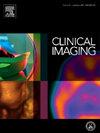Exploring the quadrilateral space: Clinical anatomy, pathology, and imaging insights
IF 1.8
4区 医学
Q3 RADIOLOGY, NUCLEAR MEDICINE & MEDICAL IMAGING
引用次数: 0
Abstract
Quadrilateral Space Syndrome (QSS) is a rare clinical entity characterised by neurovascular compression within the quadrilateral space, a confined anatomical region bounded by the teres minor, teres major, long head of the triceps brachii, and the surgical neck of the humerus. The syndrome primarily affects the axillary nerve and posterior circumflex humeral artery (PCHA), presenting with nonspecific symptoms such as shoulder pain, paresthesia, and muscle weakness. Imaging plays a pivotal role in diagnosing QSS, with magnetic resonance imaging (MRI) serving as the gold standard. Ultrasound complements MRI by dynamically assessing neurovascular structures and detecting vascular compromise using Doppler imaging. Other imaging modalities, including radiography and computed tomography (CT), are valuable for identifying bony abnormalities or associated space-occupying lesions like osteochondromas or bone tumours. Management of QSS involves a stepwise approach. Conservative treatments, such as physical therapy and ultrasound-guided steroid injections, are first-line interventions aimed at alleviating symptoms and addressing contributing factors. Surgical decompression is reserved for refractory cases, particularly when fibrous bands, space-occupying lesions, or vascular complications such as thrombosis or aneurysms are identified. A thorough understanding of the anatomical and radiological features of QSS, combined with a tailored management strategy, is crucial for optimising outcomes in affected patients. This review aims to provide a comprehensive overview of the clinical anatomy, imaging findings, and management strategies for QSS.
求助全文
约1分钟内获得全文
求助全文
来源期刊

Clinical Imaging
医学-核医学
CiteScore
4.60
自引率
0.00%
发文量
265
审稿时长
35 days
期刊介绍:
The mission of Clinical Imaging is to publish, in a timely manner, the very best radiology research from the United States and around the world with special attention to the impact of medical imaging on patient care. The journal''s publications cover all imaging modalities, radiology issues related to patients, policy and practice improvements, and clinically-oriented imaging physics and informatics. The journal is a valuable resource for practicing radiologists, radiologists-in-training and other clinicians with an interest in imaging. Papers are carefully peer-reviewed and selected by our experienced subject editors who are leading experts spanning the range of imaging sub-specialties, which include:
-Body Imaging-
Breast Imaging-
Cardiothoracic Imaging-
Imaging Physics and Informatics-
Molecular Imaging and Nuclear Medicine-
Musculoskeletal and Emergency Imaging-
Neuroradiology-
Practice, Policy & Education-
Pediatric Imaging-
Vascular and Interventional Radiology
 求助内容:
求助内容: 应助结果提醒方式:
应助结果提醒方式:


